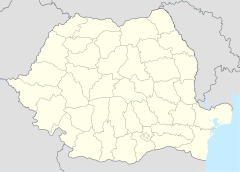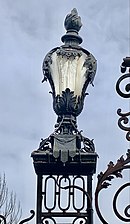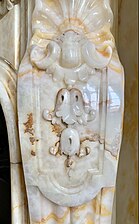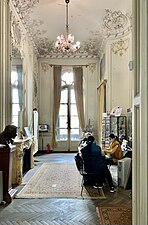Cantacuzino Palace
| Cantacuzino Palace Palatul Cantacuzino | |
|---|---|
 | |
| General information | |
| Architectural style | Beaux Arts & Rococo Revival |
| Town or city | Bucharest |
| Country | |
| Coordinates | 44°26′55″N 26°05′18″E / 44.4487°N 26.0883°E |
| Construction started | 1898[1] |
| Completed | 1906[2] |
| Design and construction | |
| Architect(s) | Ion D. Berindey |
Cantacuzino Palace is located on Calea Victoriei no. 141, Bucharest, Romania. It was built by architect Ion D. Berindey in the Beaux Arts style, having a few Rococo Revival rooms. Today it houses the George Enescu museum.[3]
History
[edit]The palace was built in 1901–1902 for Gheorghe Grigore Cantacuzino, mayor of Bucharest and former prime-minister, after the plans of Ion D. Berindey, in the French Beaux Arts style. After his death, the building was inherited by his son Mihail G. Cantacuzino, who died prematurely in 1929. Mihail's wife Maria remarried in December 1939 with music composer George Enescu. On 10 August 1913, at the end of the Second Balkan War, the Treaty of Bucharest was signed here.[4] The building – known as Cantacuzino Palace at the time – also hosted the Presidency of the Council of Ministers in the eve of World War II.
After the death of George Enescu in 1955, his wife stated in her will that the palace would host a museum dedicated to the artist. In 1956, The National Museum George Enescu was established.[5][6]
Description
[edit]The exterior and most of the rooms are Beaux Arts, the rest being Rococo Revival. The two lions at the entrance, and the gates and fences, in the Louis XIV style, give the building a princely look. The palace had the fame of a place in Bucharest where balls were held.[7] For the decoration of the interiors, Gheorghe Grigore Cantacuzino turned to the most famous artists of the time: George Demetrescu Mirea, Nicolae Vermont and Costin Petrescu. Nicolae Vermont made six medallions (oil on canvas embossed on the wall), three of which were signed and dated 1907. Five of the six medallions are placed above the doors in the hallway that led to the rooms to the right of the entrance. Two of them, Shepherd with Sheep (Cioban cu Oile) and Peasant Woman with Vessel (Țărăncuță cu Cofă), are directly inspired by the work of Nicolae Grigorescu, under whose influence was their author.[8]
In present day, about only five rooms can be visited, the rest being occupied by some institutions.
Gallery
[edit]-
The Palace during the Belle Époque (1877-1916), before the construction of the building at the intersection of Calea Victoriei and Strada Frumoasă
-
Detail of one of the gates
-
A smaller gate of the palace
-
Detail of that smaller gate of the palace
-
View of the palace, with its pair of Louis XIV style lions at the entrance
-
The glass and metal entrance of the palace
-
Wall of the entrance room
-
Handle of a door in the entrance room
-
Door in the ground floor hallway
-
Peasant Woman with Vessel (Țărăncuță cu Cofă) by Nicolae Vermont, surrounded by Rococo Revival stuccos in the room where tickets and souvenirs are sold
-
Rococo Revival chimneypiece in the room where tickets and souvenirs are sold
-
Detail of Rococo Revival stuccos in the same room
-
That room
-
Door of another room, filled with stuccos
-
Astonishing highly decorated ceiling in a salon
References
[edit]- ^ Mariana Celac, Octavian Carabela and Marius Marcu-Lapadat (2017). Bucharest Architecture - an annotated guide. Ordinul Arhitecților din România. p. 90. ISBN 978-973-0-23884-6.
- ^ Mariana Celac, Octavian Carabela and Marius Marcu-Lapadat (2017). Bucharest Architecture - an annotated guide. Ordinul Arhitecților din România. p. 90. ISBN 978-973-0-23884-6.
- ^ Palatul Cantacuzino sau Muzeul George Enescu – București
- ^ Mihaela Stoica. "Palatul Cantacuzino, locul unde Nababul a interzis fumatul, iar George Enescu era oaspetele preferat al Marucăi. Pe Regina Maria o primea stând jos". Retrieved 12 December 2018.
- ^ National Institute of Historical Monuments – Cantacuzino palace Archived January 19, 2015, at the Wayback Machine
- ^ Dan Berindei, Sebastian Boniface – Bucharest Travel Guide, Ed. Sport-Tourism, Bucharest, 1980
- ^ Popescu, Alexandru (2018). Casele și Palatele Bucureștilor (in Romanian). Editura Cetatea de Scaun. p. 113. ISBN 978-606-537-382-2.
- ^ Oprea, Petre (1986). Itinerar Inedit prin Case Vechi din București (in Romanian). Editura Sport-Turism. p. 37.
External links
[edit]- (in English) Official website
- (in Romanian) Cantacuzino Palace and George Enescu Museum



















